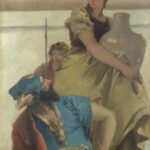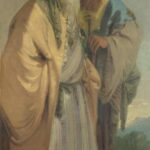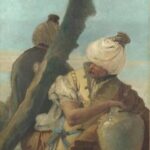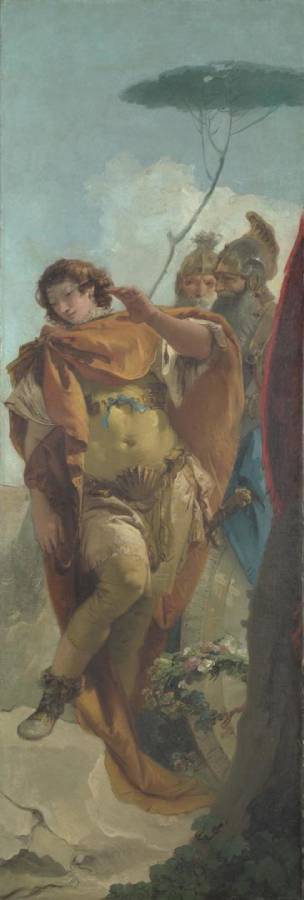Tiepolo, Giambattista (1696-1770)
La vergogna di Rinaldo davanti allo scudo magico (Rinaldo turning in Shame from the Magic Shield)
c.1740–1746
Oil on canvas, 161.3 × 53.5 cm
National Gallery, London
This painting shows Rinaldo, a Christian knight who has been enchanted by the Saracen sorceress Armida, turning away from his own reflection in a magic shield. With the spell broken, Rinaldo gives up his love for Armida and escapes with his companions, Carlo and Ubaldo, who stand nearby wearing elaborate helmets.
This scene is taken from an episode in Torquato Tasso’s Jerusalem Delivered, a sixteenth-century epic poem about the First Crusade, a Christian military campaign to recapture Jerusalem from Islamic rule. Rinaldo’s clothing and armour is inspired by the Classical world: the scallop shell at his waist was in Antiquity the attribute of Venus, the goddess of love.
Painted during the 1740s, at the height of Giovanni Battista Tiepolo’s career, this is one of four pictures in a series that once decorated a room in the Palazzo Cornaro on the Campo San Polo, Venice. The other paintings – Seated Man, Woman with Jar, and Boy, Two Standing Figures and Two Men seated under a Tree – also depict figures inspired by Tasso’s poem. (NG)
The other paintings in the series:
 Tiepolo, Giambattista (1696-1770)
Tiepolo, Giambattista (1696-1770)
Adrasto assiso ai piedi d’Armida
c.1740–1746
National Gallery, London
 Tiepolo, Giambattista (1696-1770)
Tiepolo, Giambattista (1696-1770)
Il mago d’Ascalona
c.1740–1746
National Gallery, London
 Tiepolo, Giambattista (1696-1770)
Tiepolo, Giambattista (1696-1770)
Tisaferno e Vafrino
c.1740–1746
National Gallery, London
These four narrow canvases were painted during the 1740s by Giovanni Battista Tiepolo to decorate a room on the second floor of the Palazzo Cornaro on the Campo San Polo, Venice. Tiepolo was enjoying growing fame across Italy at this time; receiving important commissions for large ceiling paintings and wall decorations.
The paintings formed part of a complex decorative scheme, with which a ceiling painting (now in Canberra) and four allegorical figures (now divided between New York and Amsterdam), have been associated. Tiepolo’s four paintings in the National Gallery – Rinaldo turning in Shame from the Magic Shield, Seated Man, Woman with Jar and Boy, Two Standing Figures and Two Men seated under a Tree – are inspired by Torquato Tasso’s popular sixteenth-century poem Jerusalem Delivered. Set during the First Crusade, a Christian military campaign to recapture Jerusalem from Islamic rule, the poem tells of the ill-fated love between the Saracen sorceress Armida and Rinaldo, a Christian knight. Tiepolo’s pale pastel tones and lively brushwork in these scenes create a dazzling atmosphere that evokes the poem’s setting. (NG)
See also:
• Tasso, Torquato (1544-1595)
